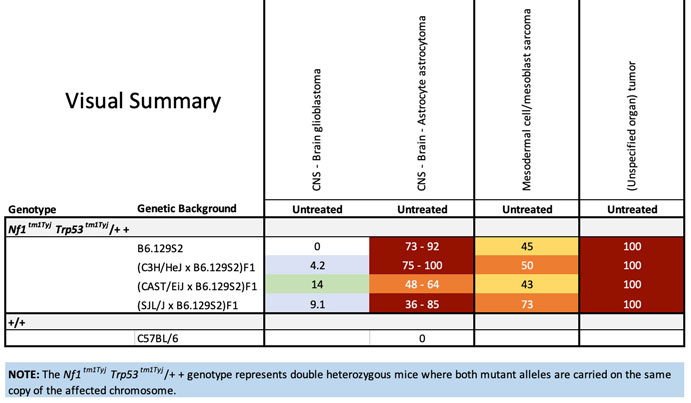Reference SummaryReilly KM, Nat Genet 2000 Sep;26(1):109-13
Title |
Nf1;Trp53 mutant mice develop glioblastoma with evidence of strain-specific effects | ||||
Authors |
Reilly KM; Loisel DA; Bronson RT; McLaughlin ME; Jacks T | ||||
Journal |
Nat Genet | ||||
Volume |
26 | ||||
Issue |
1 | ||||
Year |
2000 | ||||
Pages |
109-13 | ||||
Abstract |
Astrocytomas are the leading cause of brain cancer in humans. Because these tumours are highly infiltrative, current treatments that rely on targeting the tumour mass are often ineffective. A mouse model for astrocytoma would be a powerful tool for dissecting tumour progression and testing therapeutics. Mouse models of astrocytoma have been designed to express oncogenic proteins in astrocytes, but have had limited success due to low tumour penetrance or limited tumour progression (1-3). We present here a mouse model of astrocytomas involving mutation of two tumour-suppressor genes, Nf1 and Trp53. Humans with mutations in NF1 develop neurofibromatosis type I (NF1) and have increased risk of optic gliomas, astrocytomas and glioblastomas (4,5). The TP53 tumour suppressor is often mutated in a subset of astrocytomas that develop at a young age and progress slowly to glioblastoma (termed secondary glioblastomas, in contrast to primary glioblastomas that develop rapidly de novo (6-10). This mouse model shows a range of astrocytoma stages, from low-grade astrocytoma to glioblastoma multiforme, and may accurately model human secondary glioblastoma involving TP53 loss. This is the first reported mouse model of astrocytoma initiated by loss of tumour suppressors, rather than overexpression of transgenic oncogenes. | ||||
Links |
J:64364 – MGI References 10973261 – National Library of Medicine/PubMed |
||||
Strain Notes
|
|||||

| |||||
| Strain | Model Name | Treatment Agent(s) | Organ Affected | Frequency | Model Details |
|---|---|---|---|---|---|
| C57BL/6 | CNS - Brain - Astrocyte astrocytoma | CNS - Brain - Astrocyte |
0 |
||
| B6.129S2-Nf1tm1Tyj Trp53tm1Tyj/+ + | CNS - Brain - Astrocyte astrocytoma | CNS - Brain - Astrocyte |
73 - 92 |
||
| (C3H/HeJ x B6.129S2)F1-Nf1tm1Tyj Trp53tm1Tyj/+ + | CNS - Brain - Astrocyte astrocytoma | CNS - Brain - Astrocyte |
75 - 100 |
||
| (SJL/J x B6.129S2)F1-Nf1tm1Tyj Trp53tm1Tyj/+ + | CNS - Brain - Astrocyte astrocytoma | CNS - Brain - Astrocyte |
36 - 85 |
||
| (CAST/EiJ x B6.129S2)F1-Nf1tm1Tyj Trp53tm1Tyj/+ + | CNS - Brain - Astrocyte astrocytoma | CNS - Brain - Astrocyte |
48 - 64 |
||
| (C3H/HeJ x B6.129S2)F1-Nf1tm1Tyj Trp53tm1Tyj/+ + | CNS - Brain glioblastoma | CNS - Brain |
4.2 |
||
| B6.129S2-Nf1tm1Tyj Trp53tm1Tyj/+ + | CNS - Brain glioblastoma | CNS - Brain |
0 |
||
| (CAST/EiJ x B6.129S2)F1-Nf1tm1Tyj Trp53tm1Tyj/+ + | CNS - Brain glioblastoma | CNS - Brain |
14 |
||
| (SJL/J x B6.129S2)F1-Nf1tm1Tyj Trp53tm1Tyj/+ + | CNS - Brain glioblastoma | CNS - Brain |
9.1 |
||
| B6.129S2-Nf1tm1Tyj Trp53tm1Tyj/+ + | Mesodermal cell/mesoblast sarcoma | Mesodermal cell/mesoblast |
45 |
||
| (C3H/HeJ x B6.129S2)F1-Nf1tm1Tyj Trp53tm1Tyj/+ + | Mesodermal cell/mesoblast sarcoma | Mesodermal cell/mesoblast |
50 |
||
| (SJL/J x B6.129S2)F1-Nf1tm1Tyj Trp53tm1Tyj/+ + | Mesodermal cell/mesoblast sarcoma | Mesodermal cell/mesoblast |
73 |
||
| (CAST/EiJ x B6.129S2)F1-Nf1tm1Tyj Trp53tm1Tyj/+ + | Mesodermal cell/mesoblast sarcoma | Mesodermal cell/mesoblast |
43 |
||
| B6.129S2-Nf1tm1Tyj Trp53tm1Tyj/+ + | (Unspecified organ) tumor | (Unspecified organ) |
100 |
||
| (C3H/HeJ x B6.129S2)F1-Nf1tm1Tyj Trp53tm1Tyj/+ + | (Unspecified organ) tumor | (Unspecified organ) |
100 |
||
| (SJL/J x B6.129S2)F1-Nf1tm1Tyj Trp53tm1Tyj/+ + | (Unspecified organ) tumor | (Unspecified organ) |
100 |
||
| (CAST/EiJ x B6.129S2)F1-Nf1tm1Tyj Trp53tm1Tyj/+ + | (Unspecified organ) tumor | (Unspecified organ) |
100 |